View in other NatureServe Network Field Guides
NatureServe
Montana
Utah
Wyoming
Idaho
Wisconsin
British Columbia
South Carolina
Yukon
California
New York
Lake Disc - Discus brunsoni
General Description
The shell is large for the genus, to 10.5 mm diameter, 4.5 mm in height, umbilicus to 3.5 mm diameter, shell depressed in profile with a low spire, to about 5 1/2 compressed whorls with a strongly (but not acutely) carinate periphery. Shell color is olive-brown, the basal surface tends to be a little lighter grayish-brown. There are no spiral bands, but the chitonous shell is wrinkled and weakly ribbed on the upper surface, the irregularities almost absent on the basal surface of adult shells. Dorsal surface of the animal is dark gray to blackish on the head and neck (Hendricks 2012; Burke 2013). Internal anatomy not described.
Phenology
Active during cool and moist weather (Hendricks 1998), otherwise not described.
Diagnostic Characteristics
A combination of shell shape (flattened heliciform or flattened conic), shell dimensions, number of whorls, shell color (olive-brown and chitinous), the presence of radial striations on the shell, lack of reflected lip, and lack of teeth in the aperture distinguish this from all other Montana land snails (Hendricks 2003, 2012), including other Discus (which are smaller in diameter and more strongly ribbed).
Species Range
Montana Range
Range Descriptions
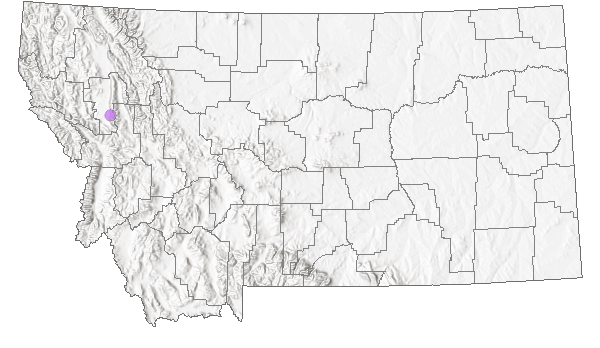
 Native
Native
Range Comments
Montana endemic: global range as currently known consists of a single boulder/talus slope of about 20,000 m sq. in the Mission Mountains, Lake County, at about 1128 m average elevation. Original description was based on specimens collected in 1948 and 1950 from slopes above McDonald Lake. As many as 39 individuals were found at this site during a single visit in early June; last reported in 1997 (Hendricks 1998, 2012; Burke 2013).
Observations in Montana Natural Heritage Program Database
Number of Observations: 9
(Click on the following maps and charts to see full sized version)
Map Help and Descriptions
Relative Density
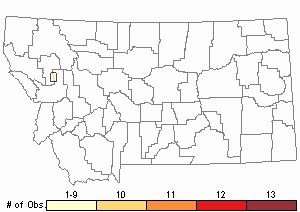
Recency
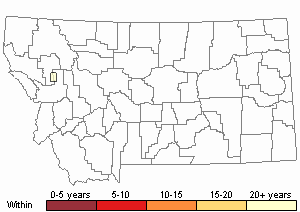
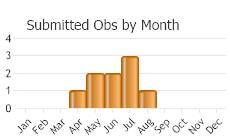
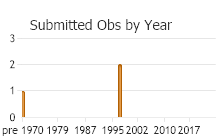
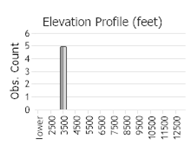 (Observations spanning multiple months or years are excluded from time charts)
(Observations spanning multiple months or years are excluded from time charts)
Migration
Non-migratory; appears to make vertical movements through talus and boulder fields (Brunson 1956; Hendricks 1998).
Habitat
Described originally as south-facing limestone talus (Berry 1955), but reexamination of the rock revealed the occupied slope to be predominately diorite with a minor amount of argillite. The slope lacks canopy cover, except at the margins where Douglas-fir and ponderosa pine occur, with scattered pockets of aspen, water birch, and mock orange (Hendricks 1998). This species appears to make vertical migrations through deep talus and boulder fields (Brunson 1956), making it all the more difficult to locate except under ideal moisture and temperature conditions.
Food Habits
Not described, but may feed on lichen attached to rock (Hendricks 1998).
Reproductive Characteristics
Not described.
Stewardship Responsibility
Threats or Limiting Factors
Although the occupied habitat is not particularly threatened by development or agriculture (logging and grazing), habitat requirements and food habits are poorly understood. Fire suppression efforts (especially use of fire retardants) and talus destabilization (trail maintenance, modification) could have negative impacts. Also, given the trail-side location, weed control efforts could negatively impact the population (Hendricks 2003).
References
- Literature Cited AboveLegend:
 View Online Publication
View Online Publication Berry, S.S. 1955. An important new land snail from the Mission Range, Montana. Bulletin of the Southern California Academy of Sciences 54: 17-19.
Berry, S.S. 1955. An important new land snail from the Mission Range, Montana. Bulletin of the Southern California Academy of Sciences 54: 17-19. Brunson, R.B. 1956. The mystery of Discus brunsoni. Nautilus 70: 16-21.
Brunson, R.B. 1956. The mystery of Discus brunsoni. Nautilus 70: 16-21. Burke, T. E. 2013. Land snails and slugs of the Pacific Northwest. Corvallis, OR: Oregon State University Press. 344 p.
Burke, T. E. 2013. Land snails and slugs of the Pacific Northwest. Corvallis, OR: Oregon State University Press. 344 p. Hendricks, P. 1998. Rediscovery of Discus brunsoni Berry, 1955 and Oreohelix alpina (Elrod 1901) in the Mission Mountains, Montana, with comments on Oreohelix elrodi (Pilsbry 1900). The Nautilus 112(2): 58-62.
Hendricks, P. 1998. Rediscovery of Discus brunsoni Berry, 1955 and Oreohelix alpina (Elrod 1901) in the Mission Mountains, Montana, with comments on Oreohelix elrodi (Pilsbry 1900). The Nautilus 112(2): 58-62. Hendricks, P. 2003. Status and conservation management of terrestrial mollusks of special concern in Montana. Unpublished report prepared for the U.S. Forest Service. Montana Natural Heritage Program, Helena, Montana. 67 pp. + appendices.
Hendricks, P. 2003. Status and conservation management of terrestrial mollusks of special concern in Montana. Unpublished report prepared for the U.S. Forest Service. Montana Natural Heritage Program, Helena, Montana. 67 pp. + appendices. Hendricks, P. 2012. A Guide to the Land Snails and Slugs of Montana. A report to the U.S. Forest Service - Region 1. Montana Natural Heritage Program, Helena, MT. vii + 187 pp. plus appendices.
Hendricks, P. 2012. A Guide to the Land Snails and Slugs of Montana. A report to the U.S. Forest Service - Region 1. Montana Natural Heritage Program, Helena, MT. vii + 187 pp. plus appendices.
- Additional ReferencesLegend:
 View Online Publication
View Online Publication
Do you know of a citation we're missing? Frest, T.J. and E.J. Johannes. 1995. Interior Columbia Basin mollusk species of special concern. Final report to the Interior Columbia Basin Ecosystem Management Project, Walla Walla, WA. Contract #43-0E00-4-9112. 274 pp. plus appendices.
Frest, T.J. and E.J. Johannes. 1995. Interior Columbia Basin mollusk species of special concern. Final report to the Interior Columbia Basin Ecosystem Management Project, Walla Walla, WA. Contract #43-0E00-4-9112. 274 pp. plus appendices.
- Web Search Engines for Articles on "Lake Disc"
- Additional Sources of Information Related to "Snails / Slugs"





